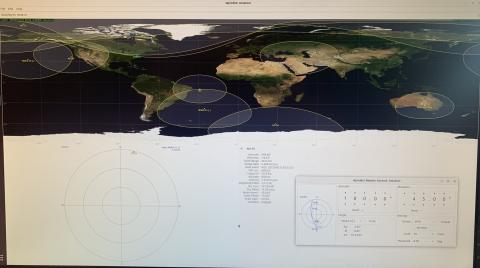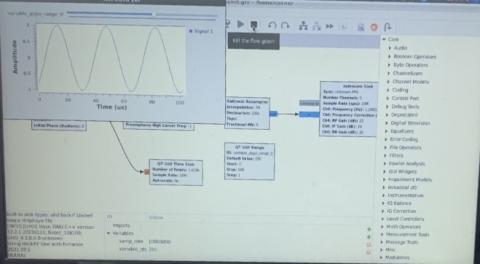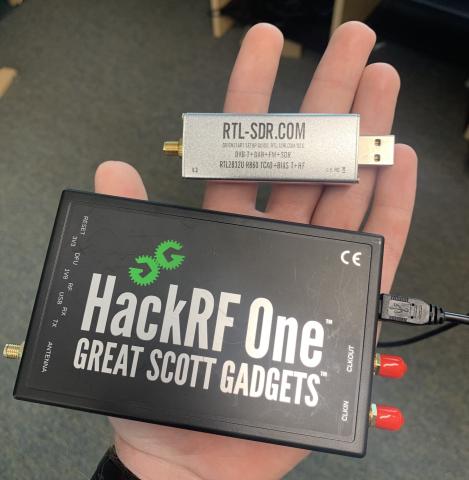At Capitol Technology University, our unique, hands-on centers and labs are just one of the ways in which our undergraduates grow into outstanding, job ready professionals. We are excited to unveil a new project that is underway within our Astronautical Engineering and Space Program that will ensure our students have job relevant experience that highlights their hard work and talents.
A new satellite ground station terminal has been developed by Professor Marcel Mabson and students, including Elijah Emory who has taken the initiative as the summer lead on this project.
Preparation for this project started a year ago, when Professor Mabson conceived the idea and set about ordering over a dozen SPID rotor mounts and dish materials from another university to get the project started. The purpose of this project is to develop a low-cost software-integrated mechanism to recognize and track satellites in Low Earth Orbit (LEO) to collect spacecraft telemetry and perform spacecraft ranging to calculate a satellite’s orbital path. The new stations will also allow our AE students the opportunity to calculate signal to noise ratios, analyze radio frequency (RF) telemetry spectrum and develop a hands-on understanding of spacecraft ground station operations and automation. Once the initial prototypes are completed, the stations will be used to collect spacecraft telemetry from orbiting CubeSat missions with the goal of deploying other stations to universities, to increase spacecraft ground coverage for CubeSat missions.
The first steps, and Elijah’s initial tasks, involved troubleshooting two of the sample dishes utilizing this newly acquired equipment, as well as finding any faulty cables, rotors, and control boxes, installing firmware updates, and contacting the product companies for documentation. With the help of student Mike Prebble, Elijah was able to solder the necessary cables and get the rotors working.
The next steps were to find a software solution that could communicate with these rotors and configure them to be remotely controllable via a PC, in addition to being able to track satellite positions. After some troubleshooting and the downloading of several libraries, Elijah decided that G-predict was the best software for the job. Using the SPID control box's USB port and HAMLib compatibility, he was able to control the rotors via terminal commands on a PC. After a few more steps, G-predict was able to use HAMLib control and with some manual configuration, G-predict was now pointing the dish at satellites! This important step verified G-predicts ability to transmit positional commands to the rotator and for the rotator and power supplies to respond as predicted.
Elijah then focused on the receiver’s feed to see if it was capable of both receiving and transmitting to ensure that broadcasting and commanding would be viable options in the future. To receive initially, he used SDR Sharp, a program that works with small USB dongles to turn a computer into a software defined radio (SDR). Elijah notes “Sharp is a lot of fun, and allows you to try different modulation, decoding, and spectrum views of radio.”
For transmitting, he used GNU radio companion software and a HackRF One device. GNU allows for customization of radio parameters in a flowchart, which makes it a great resource for this type of project. It also supports transmitting, making it perfect to use in conjunction with the HackRF One as this device can both transmit and receive signals.
After an initial test with one dish, student Stoil Avramov assisted Elijah in hauling the dish out of the fusion lab and down to the first floor where the other dish was configured. One antenna was then set up to use GNU and broadcast test frequencies, and the other was located across the first floor of our McGowan Building listening on SDR Sharp. The dish antenna only works with certain frequencies due to the mesh comprising the dish only reflects wavelengths larger than the holes in that mesh. The hardware in the feed (the orange extension in front of the dish) is also designed to handle only a few frequency ranges. During this testing, Elijah tried frequencies that these dishes were not rated for in order to confirm they were working correctly. And sure enough, no signal was received! He then performed further troubleshooting and selected a compatible frequency listed on the feed, and he got a signal that stretched across McGowan between the two dishes. Success! An additional test was performed to simulate the end of a spacecraft contact, Elijah disabled rotator control on one of the dishes and by slowly rotating the other out of the “line of sight” verified that signal was lost.
Elijah attributes his studies at Capitol and the dedication of his professors to his ability to apply complex astronautical engineering concepts to real-life situations and equipment builds. He states that “Dr. Conner and Dr. Hansen were incredibly valuable to helping my understanding of the software and equipment. Dr. Conner was my Satellite Communications (Sat Com) professor last semester and taught me a lot of the principles behind radios and encoding. He also made the flowchart for GNU that we tested with and explained how it worked. Dr. Hansen has been walking me and a few other students through HAM radio info for a while now, and procured a lot of the SDR hardware I was using for this project, so his knowledge and encouragement helped greatly.”
For these dishes to communicate with NOAA satellites, which would be the next step in this project, they will need compatible amplifiers and bandpass filters. Elijah is looking at ways to obtain and integrate these parts, as well as how to make the whole setup portable and able to run both the tracking and the receiver at the same time. He is going to start experimenting with G-predict, which supports running the radio through itself, while it automatically corrects for some small errors that can happen with Sat Com.
Over the course of the project, the professors and students will continue to explore options for other versatile ways to utilize this new equipment. In the meantime, more antennas still need to be built and mounted and more troubleshooting is needed, but the students are very excited for the possibilities of this receiver equipment!
Professor Mabson states that “Elijah symbolizes Capitol’s motto ‘Either find a way or make a way.’ The idea for building a spacecraft ground station was over a year in the making and to see Elijah develop this project from an idea on a board and using the systems engineering process from our courses to now having a functional spacecraft tracking station on our university that is entering testing, is a testament to the quality of our students.”
Capitol is proud to see how our students are developing solutions to today’s technology questions and becoming forward-thinking professionals. This project is still unfolding through the diligent work of our students, and we will be posting updates as they come in. Stay tuned!





